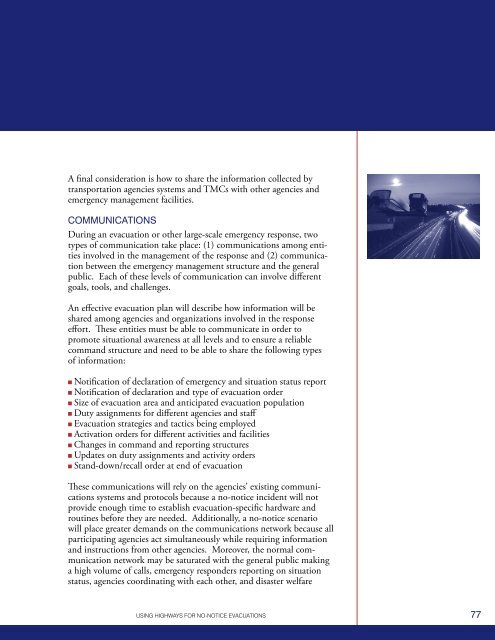using highways for no-notice evacuations - FHWA Operations - U.S. ...
using highways for no-notice evacuations - FHWA Operations - U.S. ...
using highways for no-notice evacuations - FHWA Operations - U.S. ...
You also want an ePaper? Increase the reach of your titles
YUMPU automatically turns print PDFs into web optimized ePapers that Google loves.
A final consideration is how to share the in<strong>for</strong>mation collected bytransportation agencies systems and TMCs with other agencies andemergency management facilities.COMMUNICATIONSDuring an evacuation or other large-scale emergency response, twotypes of communication take place: (1) communications among entitiesinvolved in the management of the response and (2) communicationbetween the emergency management structure and the generalpublic. Each of these levels of communication can involve differentgoals, tools, and challenges.An effective evacuation plan will describe how in<strong>for</strong>mation will beshared among agencies and organizations involved in the responseef<strong>for</strong>t. These entities must be able to communicate in order topromote situational awareness at all levels and to ensure a reliablecommand structure and need to be able to share the following typesof in<strong>for</strong>mation:n Notification of declaration of emergency and situation status reportn Notification of declaration and type of evacuation ordern Size of evacuation area and anticipated evacuation populationn Duty assignments <strong>for</strong> different agencies and staffn Evacuation strategies and tactics being employedn Activation orders <strong>for</strong> different activities and facilitiesn Changes in command and reporting structuresn Updates on duty assignments and activity ordersn Stand-down/recall order at end of evacuationThese communications will rely on the agencies’ existing communicationssystems and protocols because a <strong>no</strong>-<strong>no</strong>tice incident will <strong>no</strong>tprovide e<strong>no</strong>ugh time to establish evacuation-specific hardware androutines be<strong>for</strong>e they are needed. Additionally, a <strong>no</strong>-<strong>no</strong>tice scenariowill place greater demands on the communications network because allparticipating agencies act simultaneously while requiring in<strong>for</strong>mationand instructions from other agencies. Moreover, the <strong>no</strong>rmal communicationnetwork may be saturated with the general public makinga high volume of calls, emergency responders reporting on situationstatus, agencies coordinating with each other, and disaster welfareUSING HIGHWAYS FOR NO-NOTICE EVACUATIONS77
















